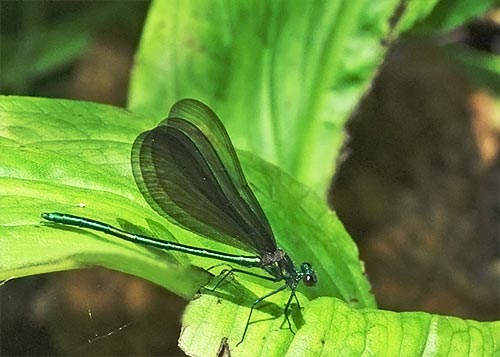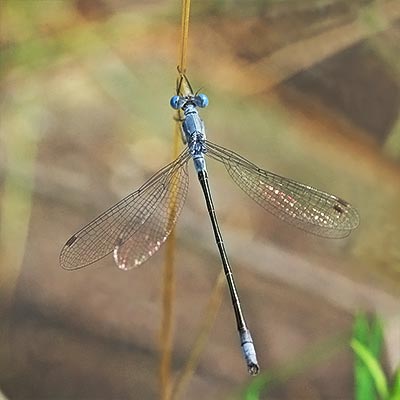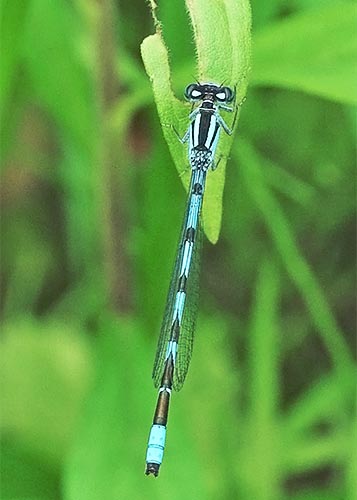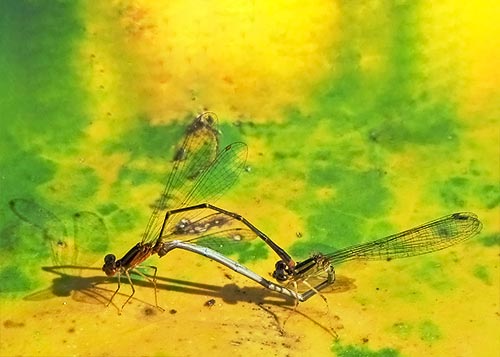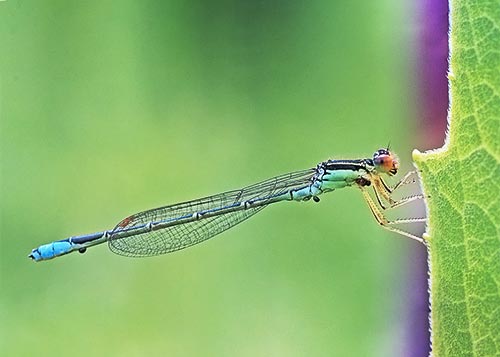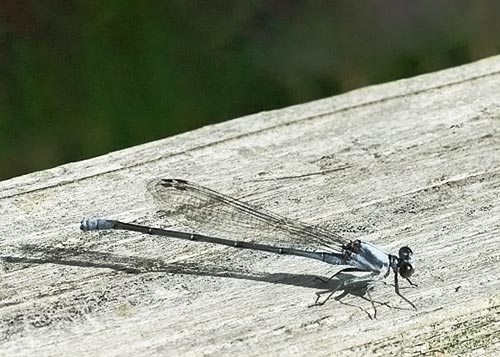Salutations, BugFans,
The BugLady and her camera have been skulking about the pond edges, feeding the mosquitoes and looking for damselflies, and there are now has many fuzzy damselfly images on the cutting room floor. Damselflies often hang out where it is dark and green and leafy (and protected from predators, which include dragonflies), and generally stay below waist height. They remind her of mini-dirigibles, floating horizontally through space and docking on a leaf or grass-top.
Damselflies
A bit about classification. Like dragonflies, damselflies are in the order Odonata. The order is divided into two sub-orders—the dragonflies (Anisoptera) and the damselflies (Zygoptera). There are three damselfly families: the broad-winged damselflies like the spectacular Ebony Jewelwing (family Calopterygidae); the spreadwing damselflies, family Lestidae, (of recent BOTW fame); and the Pond Damsels (family Coenagrionidae). Most of the damselflies the BugLady has been chasing lately have been Pond Damsels—the dancers, forktails, sprites, and the amazingly confusing bluets. Damselflies of the North Woods by Bob DuBois is a great source, with wonderful photos and good information, and so is the Beginner’s Guide to Dragonflies, by Nikula, Sones, Stokes and Stokes.
Compared to dragonflies, damselflies are small and slim. At rest, most species fold their wings along their backs, though the spread-wings may hold them out like a “V.” Except for the broad-winged damselflies, they are weak flyers. Their compound eyes look, as DuBois says, like a hammerhead—bulging out to each side.
Identification can be tricky. Males and females of many damselfly species are different colors, and older individuals, especially females, often develop waxy scales (pruinescence) that make them look powdery/hoary. Newly emerged damselflies (tenerals) are paler than mature adults. The excellent Wisconsin Odonata Survey site, has lots of pictures, and it also has county lists of dragonflies and damselflies (always remember that Odonates were issued wings, and so can go to any county they want).
The BugLady is always tickled when she can photograph a predator eating, especially when it has picked off a deer fly or mosquito that was circling her head (she saw a great picture recently of an Ebony Jewelwing eating a blood-filled mosquito that had just bitten the photographer). Speaking of food, sharp-eyed BugFans will notice little ovals on the underside of some of these damselflies’ thoraxes and abdomens. These are generally water mites (also of previous BOTW fame). Water mites attach to the damselfly’s aquatic young (naiads) and so are aboard when the damselfly emerges as an adult and takes to the air. The mites go through a parasitic stage, feeding on the damselfly like a tick. Eventually they will drop off (in the vicinity of water, if they’re lucky). The mite-load of a few of these individuals must be enervating.
So, naturalists observe, a flea has smaller fleas that on him prey; and these have smaller still to bite ’em; and so proceed ad infinitum . —Jonathan Swift
Without further ado, let’s take a look at some pond damsels, called by the estimable Canadian Naturalist John Acorn “flying neon toothpicks in the grass.” The BugLady hopes your computer will receive all 11 pictures.
Bluets
There are about 17 species of Bluets in Wisconsin, and the BugLady’s bluet IDs are shaky. She doesn’t ID many in the field; she photographs them and then agonizes over them at leisure on her monitor. As their name suggests, bluets are (most of them) blue. They are generally divided into two “ball-parks”—those with a mostly blue abdomen and those with a mostly black abdomen—and then the fun starts. The size, shape, color and location of the “eyespots”—wedges of color on the back of the eye—can be diagnostic. Separating some species involves scrutinizing what Monty Python called their “naughtybits”.
[metaslider id=4690]
Damselflies themselves don’t have ID problems—their reproductive apparatus either fits or it doesn’t. In the picture of orange bluets copulating, the male, in front, has transferred his reproductive material to a repository near his thorax, using his abdomen. As he clasps her behind the head, the female reaches forward and picks up the sperm with the tip of her abdomen. In many species, they remain joined as she lays eggs, the male upright and guarding her from other males (protecting his genetic investment, really) in a “sentinel” position.
Rainbow Bluet
Rainbow Bluet (Enallagma antennatum)—What a gem! Enough said.
Sedge Sprite
The Sedge Sprite (Nehalennia irene) is a very small (1 to 1 ½”), bright damselfly that graces much of the U.S. above the Mason-Dixon line and north into Canada. It may fold its wings above its abdomen at rest.
Eastern Forktail
Eastern Forktail (Ishnura verticalis)—The BugLady has been seeing lots of Eastern forktails lately (they emerge early and have a long flight period), and both the males and females are awesome. Hard to believe the young, brilliantly orange females will age into the slate-blue coloration. Forktails get their name from small, fork-shaped structures (allegedly) found at the tip of the abdomen. Otherwise, they may look a lot like bluets.
[metaslider id=4693]
Violet/Variable Dancer
Violet/Variable Dancer (Argia moesta)—Dancers are larger damselflies that, according to DuBois, may pale when they get cold but regain their bright colors as they warm up! Their name comes from their bouncy flight. A purple damselfly!
[metaslider id=4697]
Powdered Dancer
Powdered Dancer (Argia fumipennis violacea)—One characteristic of the dancers is their fondness for open spaces. The BugLady recently followed a Powdered dancer for 10 yards down a sunny, dusty path, trying (unsuccessfully) for a portrait.
Go outside. Find a wetland edge and watch the action. Better yet, if you’re in the neighborhood, turn out for the Riveredge Nature Center (Newburg, WI) annual Dragonfly and Damselfly count on July 23 from 10 AM to 3:30 PM. Bring a lunch if you plan to stay the whole day. Dress for the weather and wear old shoes. Please RSVP—call or email Mary Holleback at maryh@riveredge.us or 800-287-8098 if you have any questions. Beginners welcome.
The Bug Lady
